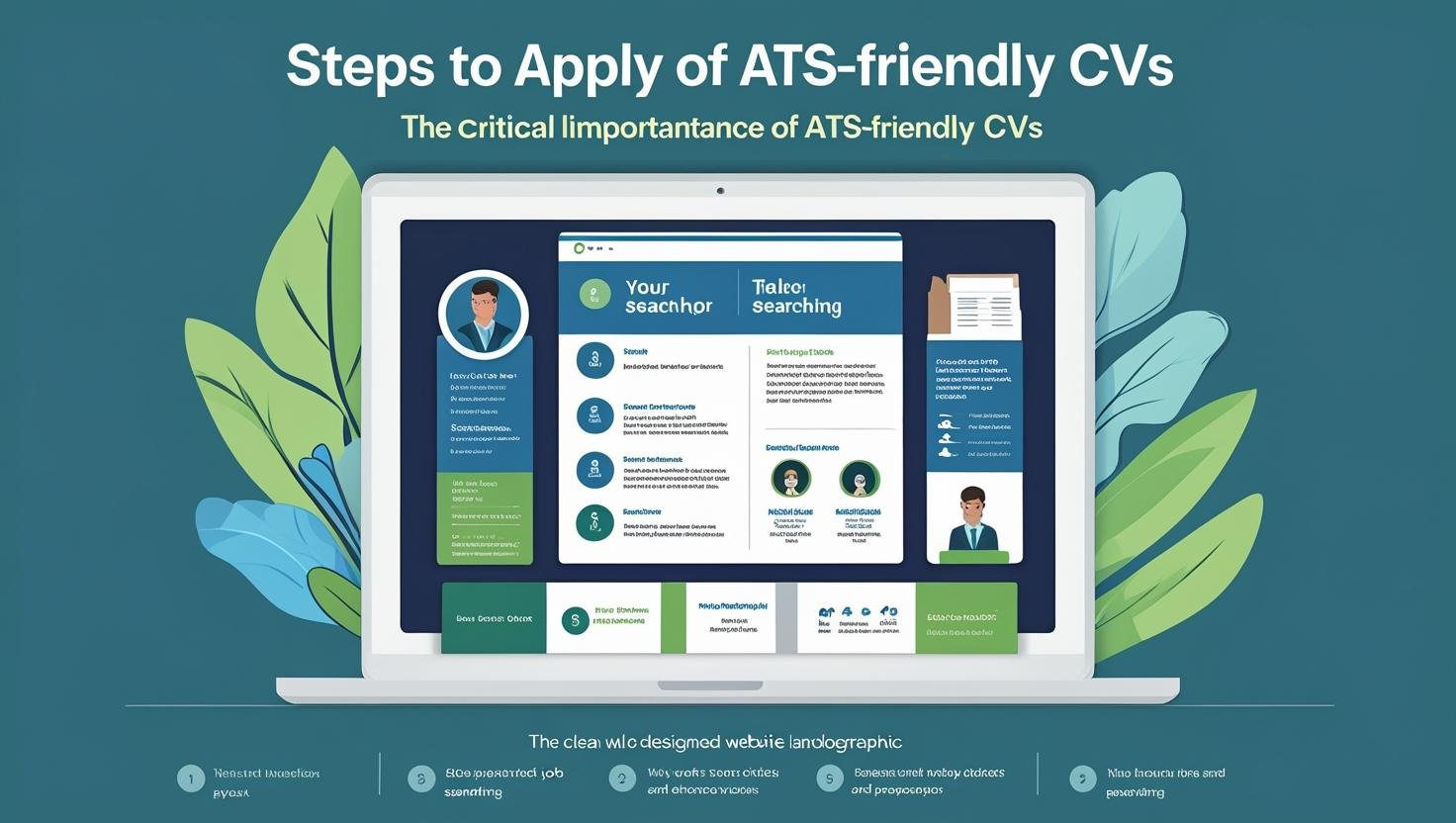In today’s competitive job market, understanding how to effectively apply for positions and crafting an Applicant Tracking System (ATS)-friendly CV has become essential for career success. With over 98% of Fortune 500 companies using ATS technology to screen applications, job seekers must adapt their strategies to navigate this digital-first hiring landscape (Capterra, 2024).
Understanding the Modern Job Application Process
The traditional job application process has undergone a significant transformation in the digital age. Today’s hiring process typically involves multiple technological touchpoints before human eyes ever see your application. According to recent studies, the average job posting receives 250 applications, but only 4-6 candidates will be called for interviews (Glassdoor, 2023). This stark reality underscores the importance of optimizing every aspect of your application strategy.
Modern recruitment has embraced automation to manage the overwhelming volume of applications. Research by Jobscan indicates that 75% of resumes are rejected by ATS before reaching human recruiters (Jobscan, 2024). This shift has fundamentally changed how job seekers must approach their applications, moving from creativity-focused resumes to optimization-focused documents that can effectively communicate with both machines and humans.

The Strategic Job Application Process
Effective job hunting begins long before you submit your first application. Career experts recommend spending 20% of your job search time on research and 80% on targeted applications rather than mass submissions (Harvard Business Review, 2023). This targeted approach involves comprehensive company research, detailed role analysis, and strategic network mapping.
Company research should encompass understanding the organization’s mission, values, recent developments, and industry position. This knowledge helps tailor your application to demonstrate genuine interest and cultural fit. Role analysis involves carefully examining job descriptions to identify key requirements, preferred qualifications, and company-specific language, ensuring your application speaks directly to employer needs.
Network mapping is equally crucial, as research suggests that 70% of jobs are never publicly advertised, making networking and internal referrals critical components of job search strategy (LinkedIn Economic Graph, 2024). The days of one-size-fits-all applications are over. Modern job seekers must customize each application to match specific role requirements. Studies show that customized applications have a 40% higher response rate than generic submissions (Indeed Hiring Lab, 2024).
The Critical Importance of ATS-Friendly CVs
Applicant Tracking Systems are software applications that automate the hiring process by electronically handling job postings, application collection, and initial candidate screening. Originally designed for large corporations, ATS usage has expanded dramatically, with 94% of large companies and 54% of mid-size companies now using these systems (Capterra, 2024).
ATS systems function by parsing CVs to extract relevant information, which is then compared against job requirements using algorithm-based matching. The system ranks candidates based on keyword relevance, qualification matches, and formatting compatibility. CVs that don’t meet minimum parsing requirements or keyword thresholds are automatically filtered out before human review.
For job seekers, the financial implications of ATS optimization are significant. Research by PayScale reveals that candidates with ATS-optimized CVs receive interview invitations 67% faster than those with traditional formats (PayScale, 2024). Faster job placement translates to reduced unemployment periods and higher lifetime earnings potential.
Essential Elements of ATS-Friendly CV Design
Creating an effective ATS-friendly CV requires understanding both technical limitations and optimization strategies. ATS systems struggle with complex formatting, graphics, and unusual fonts. Research by Resume Genius shows that CVs with simple, clean formatting have 40% higher ATS compatibility scores (Resume Genius, 2024).
Standard section headers like “Professional Experience,” “Education,” and “Skills” ensure ATS systems can properly categorize information. Consistent formatting throughout the document, including date formats, bullet points, and spacing, improves parsing accuracy significantly.
Content optimization involves strategic keyword placement, with studies indicating that CVs with 15-20 relevant keywords strategically distributed throughout the document perform best in ATS screening (TopResume, 2024). Including specific metrics and quantified achievements not only appeals to human recruiters but also helps ATS systems identify measurable accomplishments.
Technical considerations include file format selection. While PDF preserves formatting for human readers, many ATS systems prefer .docx formats for better text extraction. Research by Zety shows that .docx files have 23% better parsing rates than PDFs across major ATS platforms (Zety, 2024). Standard fonts like Arial, Calibri, or Times New Roman in 10-12 point sizes ensure maximum readability for both ATS and human reviewers.
Common ATS Pitfalls and Solutions
Many job seekers unknowingly sabotage their applications through common formatting mistakes. Research by CareerBuilder identifies critical ATS-killing errors: 89% of ATS systems cannot parse images or graphics effectively, 73% struggle with multi-column layouts and complex tables, 67% have difficulty with decorative or non-standard fonts, and 58% cannot extract information from headers and footers (CareerBuilder, 2023).
Content-related problems include keyword stuffing, which can trigger spam filters and reduce readability scores. Using only abbreviations without spelling out terms reduces keyword matching effectiveness, while inconsistent date formats confuse ATS parsing algorithms and can lead to timeline errors.
Industry-specific considerations are crucial for optimization success. Technology companies often use more sophisticated ATS systems that can better handle technical terminology but require higher keyword density, with successful candidates typically including 25-30 relevant technical terms (Stack Overflow Developer Survey, 2024). Healthcare ATS systems prioritize certification and licensing information, with properly formatted certification sections showing 45% higher screening success rates (Healthcare Financial Management Association, 2024).
Implementation Strategy and Future Trends
Successful job seekers should audit their current CV using ATS testing tools, research target roles by analyzing 10-15 similar job postings, restructure content using standard sections, integrate keywords strategically, and test improvements using ATS simulation tools. Studies by Jobscan indicate that candidates who test and optimize their CVs using ATS checkers see 34% improvement in interview invitation rates (Jobscan, 2024).
The future of ATS technology increasingly incorporates artificial intelligence and machine learning capabilities. These advanced systems can better understand context, evaluate soft skills, and assess cultural fit beyond simple keyword matching. Research by Gartner predicts that AI-enhanced ATS systems will be used by 85% of large employers by 2026 (Gartner, 2024).
However, successful job applications must balance technical optimization with compelling content that resonates with human recruiters. The most effective CVs strike a balance between machine readability and human engagement. Research by Harvard Business School shows that CVs combining ATS optimization with clear career storytelling receive 60% more interview invitations than purely technical approaches (Harvard Business Review, 2024).
Conclusion
In today’s technology-driven hiring landscape, understanding ATS optimization has become a fundamental career skill. The statistics demonstrate that candidates who invest time in understanding and optimizing for ATS systems significantly improve their chances of securing interviews and advancing their careers. The key to success lies in balancing technical optimization with compelling content, following evidence-based best practices, and staying informed about emerging trends. While ATS optimization is essential for getting past initial screening, human connections, cultural fit, and demonstrable value creation ultimately determine final hiring decisions.
References
- Capterra. (2024). Applicant Tracking System Software Research Report.
- CareerBuilder. (2023). Job Search Channel Effectiveness Study.
- Gartner. (2024). Future of Work: AI in Recruitment Technology.
- Glassdoor. (2023). Hiring Process Statistics and Trends.
- Harvard Business Review. (2023). Strategic Job Search Methodologies.
- Harvard Business Review. (2024). The Art of CV Storytelling in Digital Recruitment.
- Healthcare Financial Management Association. (2024). Healthcare Recruitment Technology Report.
- Indeed Hiring Lab. (2024). Application Customization Impact Study.
- Jobscan. (2024). ATS Resume Screening Statistics Report.
- LinkedIn Economic Graph. (2024). Hidden Job Market Analysis.
- PayScale. (2024). Impact of Resume Optimization on Job Search Duration.
- Resume Genius. (2024). ATS Compatibility Format Analysis.
- Stack Overflow Developer Survey. (2024). Technology Hiring Trends and ATS Requirements.
- TopResume. (2024). Keyword Optimization Effectiveness Study.
- Zety. (2024). File Format Performance in ATS Systems.

